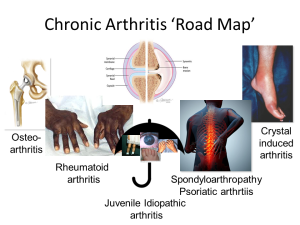
Objectives:
We started off this week with an introduction to thinking like a Rheumatologist where we covered general concepts related to synovial joints and key factors to look for in the history and physical examination of patients presenting with joint complaints. We also looked at a broad ‘road map’ for the diseases treated by Rheumatologists. In this section of the course we will focus on the diseases that primarily present with arthritis. Shown above is another concept map for this group of diseases. The next several chapters will provide you with an overview of the clinical presentation, pathophysiology and evaluation/diagnostic approach as well as complications of each of these diseases. You may also find it helpful to refer back to the Pathology of Joint Diseases Session for more information. We will apply this information during the in-class case-based session on Joint diseases.
